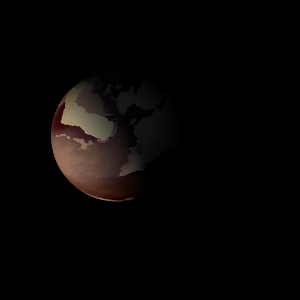|
|
Space Astro
|
Info for exoplanet "Zutea-shi"
| Scientific (actual) data |
|---|
| Name | Kepler-1667 b |
| Planet status | Confirmed |
| Radius | 0.266 |
| Orbital period | 83.5781 |
| Semi major axis | 0.386 |
| Inclination | 89.38 |
| Discovered | 2020 |
| Updated | 2021-02-05 |
| Tzero tr | 2455040 |
| Impact parameter | 0.7287 |
| Temperature (kelvin) | 520 |
| Publication | Announced on a website |
| Detection type | Primary Transit |
| Alternate names | 2MASS J18540790+4805393 b, K01311.01, KIC 10713616 b, KOI-1311 b, KOI-1311.01, WISE J185407.90+480539.6 b |
| Star name | Kepler-1667 |
| Right ascension | 283.53° |
| Declination | 48.09° |
| Mag i | 13.332 |
| Mag j | 12.429 |
| Mag h | 12.147 |
| Mag k | 12.119 |
| Star distance | 638.35 |
| Star metallicity | -0.1 |
| Star mass | 1.094 |
| Star radius | 1.06 |
| Star temperature | 5951 |
| Star alternate names | 10713616, 2MASS J18540790+4805393, KIC 10713616, KOI-1311, WISE J185407.90+480539.6 |
| Wikipedia article | Kepler-1667 b |
Back
| |
| Fictional info (?) |
|---|
| Suggested name | Zutea-shi |
| Planet type | Cold planet |
| Because of its fast rotation, the planet's shape is that of an oblate spheroid (it has a slight but noticeable bulge around the equator). |
| Estimated population | 12000000000 |
| Atmosphere | Methane | 77% |
| Carbon dioxide | 14% |
| Oxygen | 8.6% |
| Water | 0.0015% |
| Atmospheric pressure | 0.5 bar |
 |
| Moon | Gyoyocho'ra | Small irregular crater-filled moon |
| Juoka'pyosho-gya | Very small irregular oceanic moon |
| Mopyuro Shi | Medium-sized slightly egg-shaped ice comet |
| Yuhyaja Pecha | Huge irregular rocky moon |
| Nyatehe-nu | Large potato shaped ice moon |
| Zunyo Zoba | Medium-sized almost round crater-filled comet |
| Chuposa | Very small almost round crater-filled moon |
| Yotebya'sha | Very small slightly egg-shaped crater-filled asteroid |
| Gizo | Very small round crater-filled moon |
| Pehyopo Peke | Large almost round rocky comet |
| Ryabi Gyura | Very small slightly egg-shaped ice asteroid |
| Bemire-juyusha | Large potato shaped oceanic moon |
| Nyado Ze | Medium-sized irregular gaseous asteroid |
| Gyowa'pya | Huge almost round oceanic moon |
| Mubi-ka | Medium-sized round gaseous asteroid |
| Gyuzu Sha | Medium-sized irregular ice moon |
| Maja Re | Large almost round ice asteroid |
| Tozukuse Chukya | Very small potato shaped rocky comet |
| Chozu Rya | Small potato shaped rocky moon |
| Nuruta Yorobi Ne | Huge potato shaped rocky planetoid |
| Pebyo | Small almost round rocky moon |
| Chosumyo | Huge irregular oceanic moon |
| Npyubo Bato | Small slightly egg-shaped rocky moon |
| Google search for Zutea-shi |
|
Website by Joachim Michaelis
|
|
|
|